25% absorb, 25 Cal passes out transmits and total incident radiation Q = 500 J Then find out % of reflective power
To solve the problem step by step, we will analyze the given information and apply the principles of heat transfer and energy conservation.
Step 1: Understand the given data
- Total incident radiation (Q) = 500 J
- Percentage of radiation absorbed = 25%
- Transmitted radiation (QT) = 25 Cal
Step 2: Calculate the absorbed radiation (QA)
Since 25% of the incident radiation is absorbed:
QA=Percentage of absorption×Q=0.25×500 J=125 J
Step 3: Convert transmitted radiation from calories to joules
To convert calories to joules, we use the conversion factor:
1 Cal=4.2 J
Thus, for 25 Cal:
QT=25 Cal×4.2 J/Cal=105 J
Step 4: Apply the energy conservation principle
According to the principle of conservation of energy, the total incident radiation is equal to the sum of absorbed, reflected, and transmitted radiation:
Q=QA+QR+QT
Where:
- QR = reflected radiation
Substituting the known values:
500 J=125 J+QR+105 J
Step 5: Solve for reflected radiation (QR)
Rearranging the equation to find QR:
QR=500 J−125 J−105 J
QR=500 J−230 J=270 J
Step 6: Calculate the percentage of reflective power
The percentage of reflective power can be calculated using the formula:
Percentage of reflective power=(QRQ)×100
Substituting the values:
Percentage of reflective power=(270 J500 J)×100=54%
Final Answer
The percentage of reflective power is 54%.
---
- Total incident radiation (Q) = 500 J
- Percentage of radiation absorbed = 25%
- Transmitted radiation (QT) = 25 Cal
Since 25% of the incident radiation is absorbed:
QA=Percentage of absorption×Q=0.25×500 J=125 J
To convert calories to joules, we use the conversion factor:
1 Cal=4.2 J
Thus, for 25 Cal:
QT=25 Cal×4.2 J/Cal=105 J
According to the principle of conservation of energy, the total incident radiation is equal to the sum of absorbed, reflected, and transmitted radiation:
Q=QA+QR+QT
Where:
- QR = reflected radiation
500 J=125 J+QR+105 J
Rearranging the equation to find QR:
QR=500 J−125 J−105 J
QR=500 J−230 J=270 J
The percentage of reflective power can be calculated using the formula:
Percentage of reflective power=(QRQ)×100
Substituting the values:
Percentage of reflective power=(270 J500 J)×100=54%
The percentage of reflective power is 54%.
Topper's Solved these Questions
- HEAT TRANSFER & THERMAL EXPANSION BOOK - MOTIONCHAPTER - HEAT TRANSFER & THERMAL EXPANSION EXERCISE - QUESTIONS FOR PRACTICE
17 Videos
- HEAT TRANSFER & THERMAL EXPANSION BOOK - MOTIONCHAPTER - HEAT TRANSFER & THERMAL EXPANSION EXERCISE - CONCEPT BASED QUESTIONS
10 Videos
- HEAT - 1BOOK - MOTIONCHAPTER - HEAT - 1EXERCISE - EXERCISE -4 (Level - II) Previous Year | JEE Advanced
22 Videos
- HEAT-2 BOOK - MOTIONCHAPTER - HEAT-2 EXERCISE - EXERCISE-4 (LEVEL-II)
30 Videos
Similar Questions
Knowledge Check
There are 60% males out of 1000 residents in a town and out of which 20% are literate. If the total 25% of residents are literate, then what percentage of females of the town are literate?
A30B37.5C35D32.5A parallel beam of light of intensity I is incident on a glass plate. 25% of light is reflected in any reflection by upper surface and 50% of light is reflected by any reflection from lower surface. Rest is refracted The ratio of maximum to minimum intensity in interference region of reflected rays is
 A⎛⎜ ⎜⎝12+√3812−√38⎞⎟ ⎟⎠2B⎛⎜ ⎜⎝14+√3812−√38⎞⎟ ⎟⎠2C58DNone of these
A⎛⎜ ⎜⎝12+√3812−√38⎞⎟ ⎟⎠2B⎛⎜ ⎜⎝14+√3812−√38⎞⎟ ⎟⎠2C58DNone of theseOut of 10J of radiant energy incident on a surface, the energy absorbed by the surface is 2 J and the energy reflected is 7 J. Then, coefficient of transmission of the body is
A0.2B0.7C0.1Dzero
There is a loss of 25% on selling an article for Rs. 300, then find the cost price
View SolutionA good quality mirror reflects about 75% of light incident on it. How will you find out, whether 25% of the photons have not been reflected at all or all the photons have been reflected but energy of each has been reduced by 25%?
View SolutionIf 25% of the items are less than 40 and 25% are more than 60, then find the value of coefficient of quartile deviation.
View Solution_E01_107_Q01.png)
A narrow monochromatic beam of light of intensity I is incident on a galss plate as shown in figure. Another identical glass plate is kept close to the first one & parallel to it. Each glass plate reflects 25% of the light incident on it % transmits the remaining find the ratio of the minimum & the maximum intensities in the interference pattern formed by the two beams obtained after one reflection at each plate.
View SolutionAn ore contains 25% of an Alloy, out of that 90% is iron. Besides, the remaining 75% of the alloy doesn't contain any iron. Find out the required amount of the ore to get 60kg of pure iron. (approx)
View Solution
